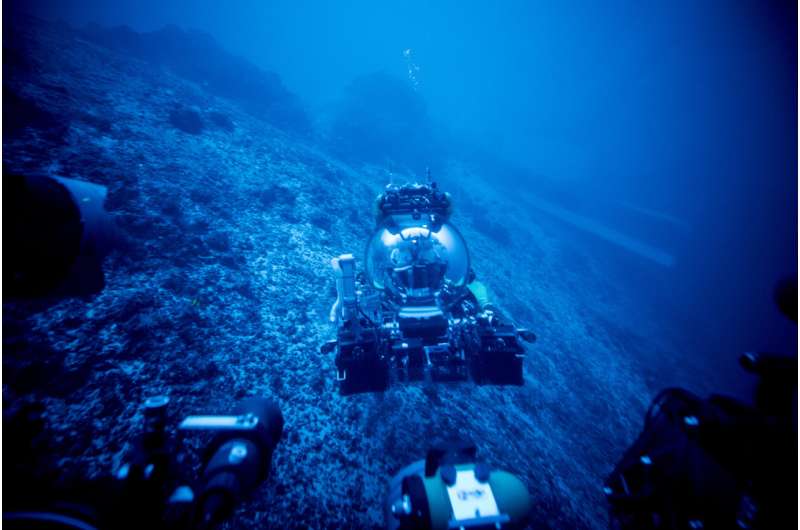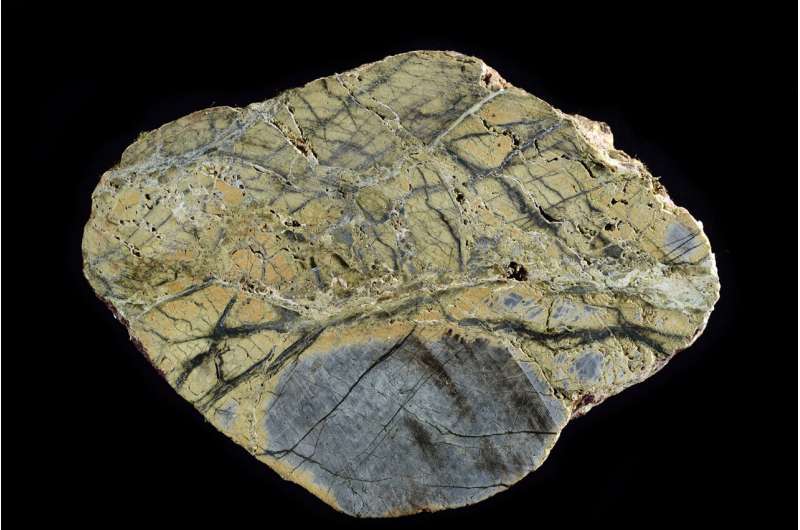This article has been reviewed according to Science X's editorial process and policies. Editors have highlighted the following attributes while ensuring the content's credibility:
fact-checked
peer-reviewed publication
trusted source
proofread
Researchers studying ocean transform faults, describe a previously unknown part of the geological carbon cycle

Studying a rock is like reading a book. The rock has a story to tell, says Frieder Klein, an associate scientist in the Marine Chemistry & Geochemistry Department at the Woods Hole Oceanographic Institution (WHOI).
The rocks that Klein and his colleagues have analyzed from the submerged flanks of the St. Peter and St. Paul Archipelago in the St. Paul's oceanic transform fault, about 500 km off the coast of Brazil, tell a fascinating and previously unknown story about parts of the geological carbon cycle.
Transform faults, where tectonic plates move past each other, are one of three main plate boundaries on Earth and about 48,000 km in length globally, with the others being the global mid-ocean ridge system (about 65,000 km) and subduction zones (about 55,000 km).
Carbon cycling at mid-ocean ridges and subduction zones has been studied for decades. In contrast, scientists have paid relatively scant attention to CO2 in oceanic transform faults. The transform faults were considered "somewhat boring" places for quite some time because of the low magmatic activity there," says Klein, lead author of "Mineral Carbonation of Peridotite Fueled by Magmatic Degassing and Melt Impregnation in an Oceanic Transform Fault," published in the Proceedings of the National Academy of Sciences (PNAS).
"What we have now pieced together is that the mantle rocks that are exposed along these ocean transform faults represent a potentially vast sink for CO2," he says.
"Partial melting of the mantle releases CO2 that becomes entrained in hydrothermal fluid, reacts with the mantle closer to the seafloor, and is captured there. This is a part of the geological carbon cycle that was not known before," said Klein
"Because transform faults have not been accounted for in previous estimates of global geological CO2 fluxes, the mass transfer of magmatic CO2 to the altered oceanic mantle and seawater may be larger than previously thought."
"The amount of CO2 emitted at the transform faults is negligible compared to the amount of anthropogenic—or human driven—CO2," says Klein. "However, on geological timescales and before humans emitted so much CO2, geological emissions from Earth's mantle—including from transform faults—were a major driving force of Earth's climate."

As the paper states, "global anthropogenic CO2 emissions are estimated to be on the order of 36 gigatons (Gt) per year, dwarfing estimates of average geological emissions (0.26 Gt per year) to the atmosphere and hydrosphere. Yet, over geological timescales, emissions of CO2 sourced from Earth's mantle have been pivotal in regulating Earth's climate and habitability, as well as the C [carbon]-concentration in surface reservoirs, including the oceans, atmosphere, and lithosphere."
Klein adds that "this is before anthropogenic combustion of fossil fuels, of course."
"In order to fully understand modern human-caused climate change, we need to understand natural climate fluctuations in Earth's deep past, which are tied to perturbations in Earth's natural carbon cycle. Our work provides insights into long-timescale fluxes of carbon between Earth's mantle and the ocean/atmosphere system," says co-author Tim Schroeder, member of the faculty at Bennington College, Vermont.
"Large changes in such carbon fluxes over millions of years have caused Earth's climate to be much warmer or colder than it is today."
To better understand carbon cycling between Earth's mantle and the ocean, Klein, Schroeder, and colleagues studied the formation of soapstone "and other magnesite-bearing assemblages during mineral carbonation of mantle peridotite" in the St. Paul's transform fault, the paper notes.
"Fueled by magmatism in or below the root zone of the transform fault and subsequent degassing, the fault constitutes a conduit for CO2-rich hydrothermal fluids, while carbonation of peridotite represents a potentially vast sink for the emitted CO2."
The researchers argue in the paper that "the combination of low extents of melting, which generates melts enriched in incompatible elements, volatiles and particularly CO2, and the presence of peridotite at oceanic transform faults creates conditions conducive to extensive mineral carbonation."
The rocks were collected using human-occupied vehicles during a 2017 cruise to the area.
Finding and analyzing these rocks "was a dream come true. We had predicted the presence of carbonate-altered oceanic mantle rocks 12 years ago, but we couldn't find them anywhere," says Klein.
"We went to the archipelago to explore for low-temperature hydrothermal activity, and we failed miserably in finding any such activity there. It was unbelievable that we were able to find these rocks in a transform fault, because we found them by chance while looking for something else."
More information: Klein, Frieder et al, Mineral carbonation of peridotite fueled by magmatic degassing and melt impregnation in an oceanic transform fault, Proceedings of the National Academy of Sciences (2024). DOI: 10.1073/pnas.2315662121
Journal information: Proceedings of the National Academy of Sciences
Provided by Woods Hole Oceanographic Institution




















